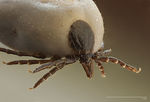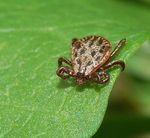Difference between revisions of "Hard Ticks - UK"
(Redirected page to Category:Hard Ticks - UK) |
|||
| (11 intermediate revisions by 2 users not shown) | |||
| Line 1: | Line 1: | ||
| − | + | [[Image:Ixodes ricinus.jpg|thumb|right|150px|''Ixodes ricinus'' - Richard Bartz, Wikimedia Commons]] | |
| + | |||
| + | ===Ixodes spp.=== | ||
| + | ''Ixodes spp.'' can be identified by; | ||
| + | *Long palps | ||
| + | *Absent eyes | ||
| + | *Not ornate | ||
| + | *No festoons | ||
| + | *Anterior anal grooves | ||
| + | There are a number of ''Ixodes'' species present in the UK, however the most prevelant are ''I.ricinus'', ''I.canisuga''and ''I.trianguliceps''. | ||
| + | |||
| + | ===Ixodes ricinus=== | ||
| + | This is a common hard tick found in the UK. As with most hard ticks ''Ixodes ricinus'' is a 3 host tick as well as a 3 stage life cycle. The ticks spend the mojority of their life on the ground, only requiring a blood meal prior to moulting to the next stage. The ''Ixodes ricinus'' life cycle normally takes 3 year but can range from 2 - 7 years in some cases, during this life cycle the tick will normally feed 3 times. After becoming adult the female will mate once whilst on the host before being shed to the ground. The female will lay several thousand eggs in matted vegetation such as rough pasture and hedgerows, following this she will die. | ||
| + | |||
| + | ===Ixodes canisuga=== | ||
| + | *Host specific dog tick | ||
| + | *Problem in kennels | ||
| + | |||
| + | ===Ixodes hexagonus=== | ||
| + | *Known as the hedgehog tick | ||
| + | *Affects hedgehogs, dogs, cats, ferrets and weasels | ||
| + | *Common in small animal practice | ||
| + | |||
| + | ===Haemaphysalis spp.=== | ||
| + | ''Haemaphysalis spp.'' can be identified by: | ||
| + | *Wide palps | ||
| + | *Rectangular base of capitulum | ||
| + | *Eyes present on idiosoma | ||
| + | *Not ornate | ||
| + | *Festoons on posterior margin | ||
| + | *Posterior anal groove | ||
| + | |||
| + | The major species found in the UK, though rarely, is ''H.punctata'', the red sheep tick. This is a three host tick that can complete its life cycle in a single year but in Wales takes between 2 - 3 years due to envirnmental conditions. ''H.punctata'' bites cause paralysis in sheep and cattle which the adults target as the third host, though they may also attach other medium to large mammals and humans. The larval and nymphal stages target small mammals, birds and lizards. As with many other ticks ''H.punctata'' transmits a number of diseases including tick born encephalitis (TBE), Q fever, tularaemia, ''Rickettsia slovaca'', ''Theileria mutans'', ''T.ovis'', ''T.recondite'', ''Babesia major'', ''B.motasi'' ''Anaplasma mesaeterum'', Crimean Congo Haemorrhagic Fever, ''Borrelia burgdorferi'' (spanish lyme disease). | ||
| + | |||
| + | ===Dermacentor spp.=== | ||
| + | [[File:Dermacentor reticulatus.jpg|150px|thumb|right|''D.reticulatus'' male - Rainer Altenkamp, Berlin, Wikimedia Commons ]] | ||
| + | ''Dermacentor spp.'' can be identified by; | ||
| + | *Wide palps | ||
| + | *Rectangular base of capitulum | ||
| + | *Eyes | ||
| + | *Ornate | ||
| + | *Posterior anal groove | ||
| + | *Festoons on the posterior margin | ||
| + | There are two species found in the UK and europe ''D.reticulatus'' and ''D.marginatus'', the ornate sheep tick however this is absent from the UK. ''D.reticulatus'' is a three host tick found on meadows, pastures and forests in England and Wales. Adults will parasitse large mammals whilst larval and nymphal stages attack small mammals, insectivores and sometimes birds. The tick is known to transmitt a number of disease in man and and veterinary species. ''D.reticulatus'' is responsible for transmitting ''Babesia canis'' in dogs, ''B.divergens'' and ''B.ovis''in cattle as well as Q fever (''C.burnetii''), tularemia, ''Brucella'', ''Anaplasma ovis'' and ''Rickettsia conorii'' the cause of Boutonneuse fever. In horse ''D.reticulatus'' is responsible for the transmission of ''Babesia caballi'' and ''B.equi''. ''D.marginatus'' | ||
| + | |||
| + | ===Rhipicephalus spp.=== | ||
| + | ''Rhipicephalus spp.'' can be identified by; | ||
| + | *Wide palps | ||
| + | *Hexagonal base of capitulum | ||
| + | *Eyes present on idiosoma | ||
| + | *Not ornate | ||
| + | *Festoons on posterior margin | ||
| + | *Posterior anal groove | ||
| + | |||
| + | There are 2 Rhipicepphalus species found in Europe; ''R.sanguineus'',the brown dog tick is found in houses and kennels in the uK as outdoor conditions are not suitable. It is a three host tick and can complete its life cycle in 4 - 5 months, though this may take longer in colder conditions. This tick transmits Lyme disease (''Borrelia burgdorferi''), ''Babesia canis'', ''B.gibson'', ''Erlichia canis'', ''E.vogeli'', ''Salmonella enteritidis'', ''Hepatozoon canis'', ''Rickettsia conorii'', Q fever, ''Rickettsia rhipicephali'' (Rocky mountain spotted fever) to dogs. ''R.bursa'', which infects horses is found in southern europe. | ||
| + | |||
| + | [[Category:Ticks]] | ||
| + | [[Category:To_Do_-_NickJ]] | ||
Revision as of 13:46, 8 July 2010
Ixodes spp.
Ixodes spp. can be identified by;
- Long palps
- Absent eyes
- Not ornate
- No festoons
- Anterior anal grooves
There are a number of Ixodes species present in the UK, however the most prevelant are I.ricinus, I.canisugaand I.trianguliceps.
Ixodes ricinus
This is a common hard tick found in the UK. As with most hard ticks Ixodes ricinus is a 3 host tick as well as a 3 stage life cycle. The ticks spend the mojority of their life on the ground, only requiring a blood meal prior to moulting to the next stage. The Ixodes ricinus life cycle normally takes 3 year but can range from 2 - 7 years in some cases, during this life cycle the tick will normally feed 3 times. After becoming adult the female will mate once whilst on the host before being shed to the ground. The female will lay several thousand eggs in matted vegetation such as rough pasture and hedgerows, following this she will die.
Ixodes canisuga
- Host specific dog tick
- Problem in kennels
Ixodes hexagonus
- Known as the hedgehog tick
- Affects hedgehogs, dogs, cats, ferrets and weasels
- Common in small animal practice
Haemaphysalis spp.
Haemaphysalis spp. can be identified by:
- Wide palps
- Rectangular base of capitulum
- Eyes present on idiosoma
- Not ornate
- Festoons on posterior margin
- Posterior anal groove
The major species found in the UK, though rarely, is H.punctata, the red sheep tick. This is a three host tick that can complete its life cycle in a single year but in Wales takes between 2 - 3 years due to envirnmental conditions. H.punctata bites cause paralysis in sheep and cattle which the adults target as the third host, though they may also attach other medium to large mammals and humans. The larval and nymphal stages target small mammals, birds and lizards. As with many other ticks H.punctata transmits a number of diseases including tick born encephalitis (TBE), Q fever, tularaemia, Rickettsia slovaca, Theileria mutans, T.ovis, T.recondite, Babesia major, B.motasi Anaplasma mesaeterum, Crimean Congo Haemorrhagic Fever, Borrelia burgdorferi (spanish lyme disease).
Dermacentor spp.
Dermacentor spp. can be identified by;
- Wide palps
- Rectangular base of capitulum
- Eyes
- Ornate
- Posterior anal groove
- Festoons on the posterior margin
There are two species found in the UK and europe D.reticulatus and D.marginatus, the ornate sheep tick however this is absent from the UK. D.reticulatus is a three host tick found on meadows, pastures and forests in England and Wales. Adults will parasitse large mammals whilst larval and nymphal stages attack small mammals, insectivores and sometimes birds. The tick is known to transmitt a number of disease in man and and veterinary species. D.reticulatus is responsible for transmitting Babesia canis in dogs, B.divergens and B.ovisin cattle as well as Q fever (C.burnetii), tularemia, Brucella, Anaplasma ovis and Rickettsia conorii the cause of Boutonneuse fever. In horse D.reticulatus is responsible for the transmission of Babesia caballi and B.equi. D.marginatus
Rhipicephalus spp.
Rhipicephalus spp. can be identified by;
- Wide palps
- Hexagonal base of capitulum
- Eyes present on idiosoma
- Not ornate
- Festoons on posterior margin
- Posterior anal groove
There are 2 Rhipicepphalus species found in Europe; R.sanguineus,the brown dog tick is found in houses and kennels in the uK as outdoor conditions are not suitable. It is a three host tick and can complete its life cycle in 4 - 5 months, though this may take longer in colder conditions. This tick transmits Lyme disease (Borrelia burgdorferi), Babesia canis, B.gibson, Erlichia canis, E.vogeli, Salmonella enteritidis, Hepatozoon canis, Rickettsia conorii, Q fever, Rickettsia rhipicephali (Rocky mountain spotted fever) to dogs. R.bursa, which infects horses is found in southern europe.

